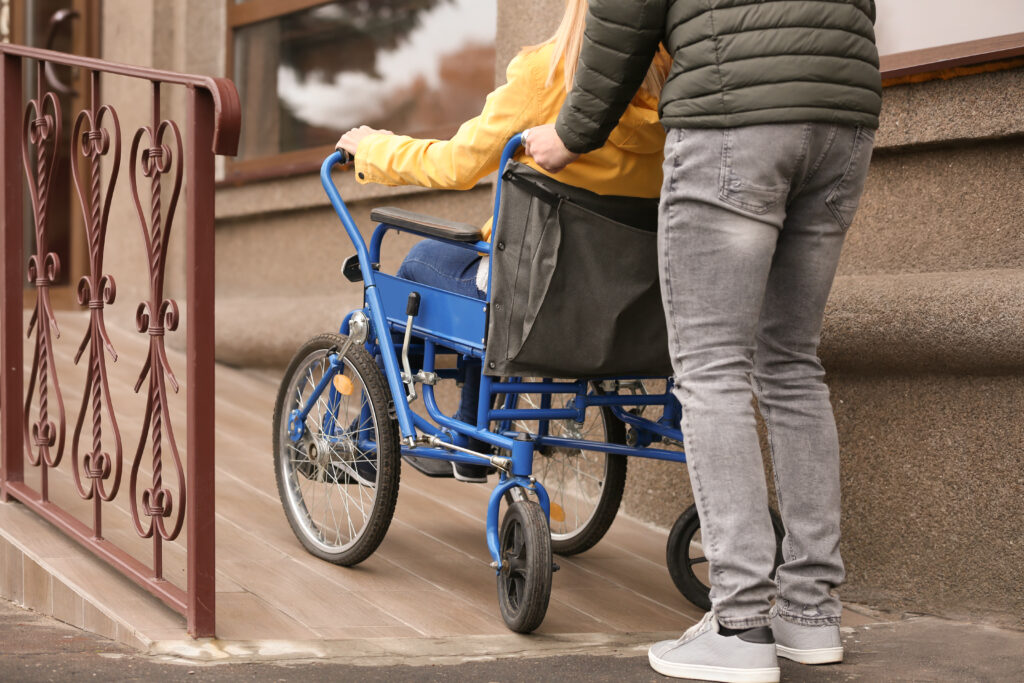Accessibility
Are Wheelchair Ramps Covered by Medicare, Medicaid, or Insurance?
If you or a loved one uses a wheelchair, adding a wheelchair ramp to your home can be life-changing. Whether it’s a portable wheelchair ramp or a more permanent aluminum wheelchair ramp, these accessibility solutions make it safer and easier to navigate everyday life. But one question we often hear is: “Are wheelchair ramps covered by Medicare, Medicaid, or insurance?”
The short answer? It depends.
In this post, we’ll break down what Medicare and Medicaid cover, when insurance might help, and how to find alternative funding if you’re looking for wheelchair ramps for homes free or at a reduced cost.
Does Medicare Cover Wheelchair Ramps?
This is one of the most common questions we get—and unfortunately, the answer is usually no.
Why Doesn’t Medicare Cover Wheelchair Ramps?
Medicare Part B covers durable medical equipment (DME) like wheelchairs, walkers, and oxygen equipment. However, it does not cover home modifications, even if those modifications are medically necessary. That includes:
- Permanent or portable wheelchair ramps
- Stair lifts
- Widening doorways
- Bathroom modifications
Medicare considers these upgrades to be home convenience features, not medical necessities—even though, for many people, a ramp is the difference between independence and confinement.
What About Medicare Advantage Plans?

Medicare Advantage (Part C) plans are run by private insurance companies. Some Advantage plans offer additional home modification benefits, but coverage varies widely.
If you’re enrolled in a Medicare Advantage plan, contact your provider to ask:
- Do you offer home modification benefits?
- Are wheelchair ramps for homes included?
- What documentation is required to qualify?
Keep in mind, even with Advantage plans, it’s rare to see full coverage for ramps. Partial reimbursement or cost-sharing might be possible in some cases.
Will Medicaid Pay for a Wheelchair Ramp?

Medicaid is more flexible than Medicare when it comes to home accessibility. Because it’s a state-managed program, coverage varies from one state to the next—but in many cases, Medicaid will help pay for a wheelchair ramp.
Common Situations Where Medicaid Covers a Ramp:
- You’re eligible for an HCBS Waiver (The most common way)
- These waivers offer services not covered by regular Medicaid, like home modifications.
- A doctor or healthcare provider usually needs to document that a ramp is medically necessary for safe access in and out of your home
- You have a disability that limits mobility
- Conditions like multiple sclerosis, ALS, spinal cord injuries, or any illness requiring a wheelchair or walker.
- The ramp improves health outcomes by preventing falls and hospitalizations.
- To avoid placement in a nursing home
- Medicaid prefers keeping people in their homes (it’s cheaper than institutional care).
- A ramp installation can be part of a care plan to support independent living.
- You qualify for a Medicaid Consumer-Directed or Self-Directed Services Program
- Some states allow participants to manage a personal budget for care and choose services, including home modifications.
- You’re part of a Managed Long-Term Services and Supports (MLTSS) program
- These Medicaid plans bundle care services and sometimes include funds for home modifications.

Typical Requirements & Application Process:

- Assessment: A Medicaid case manager, occupational therapist, or nurse visits your home to assess the need for a ramp.
- Documentation: Medical documentation from a healthcare provider stating the ramp is medically necessary
- Approval by Medicaid or Waiver Program: The request gets reviewed for medical necessity and cost-effectiveness compared to other care options (like moving to a facility).
States Where Medicaid May Cover Wheelchair Ramps
While coverage specifics vary, most states offer HCBS waivers that include home modifications. Examples of states with such programs include:
- Wisconsin: Programs like Family Care and IRIS (Include, Respect, I Self-Direct) provide funding for home modifications, including wheelchair ramps, for eligible individuals.
- Illinois: The Home Services Program under the Department of Human Services may cover home modifications such as ramps for individuals with disabilities.
- California: The In-Home Supportive Services (IHSS) program can provide assistance for home modifications, including ramps, for qualifying individuals.
- Texas: Programs like STAR+PLUS and Home and Community-based Services (HCS) waivers may cover home modifications for eligible residents.
- New York: The Nursing Home Transition and Diversion (NHTD) waiver includes provisions for home modifications such as wheelchair ramps.
Does Private Insurance Cover Wheelchair Ramps?
Private health insurance policies vary widely. In most cases, standard plans do not cover home modifications like ramps. However, if you have a disability rider, long-term care policy, or specialized supplemental coverage, you may be able to get partial coverage or reimbursement.
Always check with your insurance provider and ask:
- Are wheelchair ramps or home accessibility modifications covered?
- Do I need a doctor’s note or prescription?
- Are there preferred vendors or documentation requirements?
Even if full coverage isn’t available, some insurance companies offer flexible spending accounts (FSAs) or health savings accounts (HSAs) that allow you to use pre-tax dollars for ramp-related expenses.
Other Ways to Pay for a Wheelchair Ramp
Even if Medicare and insurance don’t offer coverage, you still have options. Many local and national programs offer grants, loans, or volunteer labor to help people install wheelchair ramps for homes free or at a reduced cost.

Alternative Resources
1. Non-Profit & Community Organizations
There are organizations across the U.S. that specialize in helping people build ramps:
- Ramp Project Directory – A national listing of local ramp-building programs by state.
- Rebuilding Together – Offers home repairs and modifications for low-income homeowners.
- United Way – Connects people with local resources and services.
- Lions Clubs and Kiwanis Clubs – Often sponsor community ramp-building efforts.
- Boy Scouts – We’ve heard of several ramps being built by Scout troops.
2. State Assistive Technology Programs
Every state has an Assistive Technology Act program, offering:
- Equipment loans or exchanges
- Demonstration centers
- Financial aid or guidance
These programs can help you find affordable solutions and may offer loaner ramps while you seek permanent funding.
3. Veterans’ Benefits
If you or your loved one is a veteran, the VA has several grant programs:
- Home Improvements and Structural Alterations (HISA)
- Specially Adapted Housing (SAH) Grants
- Special Home Adaptation (SHA) Grants
These programs can help fund aluminum wheelchair ramps, grab bars, widened doorways, and other accessibility features.
4. Local Housing Authorities
Some municipal and county housing departments offer funding for accessibility improvements, especially for seniors and low-income residents. This may include grants, loans, or deferred payment programs.
What to Know Before You Build a Ramp
If you’re considering a DIY ramp, make sure you understand local building codes and safety requirements. The Americans with Disabilities Act (ADA) recommends:
- 1 inch of rise for every 12 inches of ramp
- Minimum 36 inches width
- Sturdy handrails for longer ramps
Before Googling how to build a wheelchair ramp, consider your safety and long-term needs. Many families find that a professionally designed aluminum wheelchair ramp offers better durability, weather resistance, and peace of mind.
Choosing the Right Wheelchair Ramp for Your Home
There are several types of ramps to consider depending on your needs:
- Portable wheelchair ramp – Lightweight and foldable, great for travel or temporary access
- Modular aluminum wheelchair ramp – Permanent or semi-permanent, custom-fit to your home
- Threshold ramps – Small ramps to help get over raised door thresholds or single steps
You can explore HandiRamp’s full selection of ramps here.
Final Thoughts

While it’s frustrating that Medicare does not cover wheelchair ramps, you do have options. Medicaid, private insurance, and local organizations may be able to help. And with a little research, you can find a safe, affordable solution that meets your needs.
If you’re overwhelmed or unsure where to start, our team at HandiRamp is happy to help. We’ve been building custom accessibility solutions since 1958 and have deep experience working with families, veterans, and individuals across the country.
Your safety and independence matter—and the right wheelchair ramp can make all the difference. Looking for a ramp but unsure how to pay for it? Contact us today and let us guide you toward the best solution for your budget and situation. If you or a loved one suffer from limited mobility, we are here to help.
Helpful Links:


